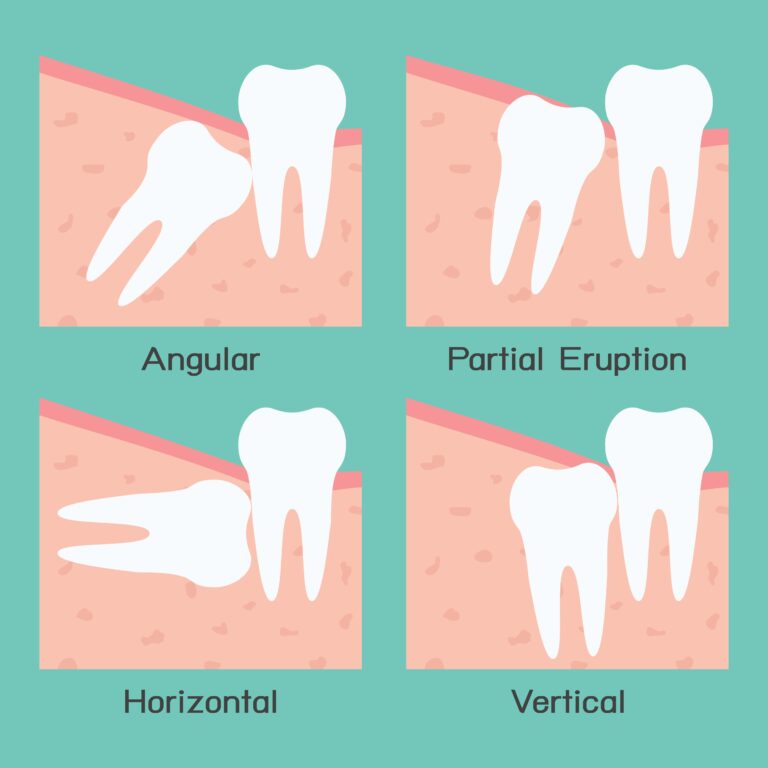Why Wisdom Tooth Hurts – Surgery, To Be Or Not To Be?
Wisdom tooth creates problems in almost everyone’s life once in a while. A few are lucky who haven’t suffered from this vestigial organ of the body, probably because they have a bigger jaw, or plain lucky to grow their wisdom teeth normally. Nonetheless, wisdom teeth can cause some serious problems such as gum infection, tooth decay and even tumours.
Wisdom teeth weren’t always the unwelcome threat we see today. Wisdom teeth are one of the vestigial organs in human beings. Our ancestors used them to grind up food as we use them today to grind food with our molars. After the advent of cooking, we used to eat soft food and our powerful jaws no longer needed to work as hard. As a result, our jaws shrank. The genes that determine the size of our jaws are different from the genes that determine the number of teeth we grow. So, our jaws shrank because of evolution but we have still kept all 32 teeth.
Now, the question is why wisdom teeth are treated like strangers and got the boot? The answer is simple. Because they are the last to show up to the party.
Wisdom Teeth – Types of Impactions
Impaction of wisdom teeth means a condition where a wisdom tooth or more than one tooth create an impact on other teeth because the tooth hasn’t erupted fully into the mouth. There are several reasons for it, but the most common reason is a lack of space. As a result, mostly this wisdom tooth lies partially or completely trapped underneath the gum. When a tooth is said to be partially impacted, it means a part of the tooth has erupted but another part is impacted.
There is no fixed time or age when this impacted tooth will create discomfort, pain or even severe damage to your dental structure. Nobody knows the exact timing but when you experience certain prevailing pain, it is better to do an x-ray to recognize the exact reason behind the pain. Another problem with partial or complete impacted wisdom teeth is hard to clean, and thus vulnerable to tooth decay and gum disease.

Types of Wisdom Teeth Impactions
Mesial Impaction
Mesial impaction is the least difficult and most commonly-occurring type of wisdom tooth impaction. Some doctors also call it angular impactions as it is characterized by an eruption of the wisdom tooth at an angle towards the front of the mouth.
Distal Impaction
Distal impaction is also a type of impaction where the tooth has erupted at an angle like mesial impaction. The difference between the two is that a distal impaction is angled towards the back of the mouth. It is also considered the rarest type of impaction.
Horizontal Impaction
Horizontal impaction is a complete impaction and probably the worst type of wisdom tooth impaction where the tooth sits horizontally underneath the gums. It is the worst painful impaction and can cause lots of damage to both teeth and gum.
Vertical Impaction
When a wisdom tooth is correctly positioned, however, is unable to erupt, the impaction is called vertical impaction. Most of the time it doesn’t require any treatment.
How Do I Know I Have an Impacted Wisdom Tooth?
You can only be sure once you check it with your dentist. He or she will do a complete x-ray to understand the position of your teeth and the reason behind the pain.
There are certain symptoms that can be considered as a reason for an impacted tooth.
- Intense pain in the back of the mouth. This is where your wisdom tooth lies, so any pain is a signal that there may be an impaction.
- Sometimes you experience swelling on both sides of your face. There may be other reasons, but you need to check with your doctor.
- Pinching pain while you chew or swallow.
- A foul taste and occasional bleeding in the mouth.
Complications of Wisdom Tooth Impaction
In some rare cases impacted wisdom teeth can cause severe problems such as:
Teeth Damage: If the impaction is against the second molar, it may damage the second molar and also spread the pain to other parts of the mouth. A prolonged impaction can damage the structure of teeth and may require orthodontic treatment to straighten other teeth.
Cysts: The sac within the jawbone is the seat of your wisdom tooth. If the problem persists, the sac can fill with fluid, and if not treated, can lead to a cyst. The cyst can damage your teeth, jawbone and nerve.
Tooth Decay: The cavity of tooth decay is the result of the long-term activities of bacteria. Since wisdom teeth are harder to clean, food particles that get trapped in between the gum and partially erupted tooth will give birth to lots of bacteria. These bacteria will eventually start decaying your tooth.
Gum Disease: Partially erupted wisdom tooth can result in a painful, inflammatory gum condition known as pericoronitis.
Impacted Wisdom Teeth Treatment
Sometimes minor pain and irritation related to wisdom teeth can be easily relieved with saltwater or pain relievers. Nevertheless, in many cases, the pain caused by an impacted wisdom tooth is not so easily treated unless you go to your doctor and understand the reason behind it.
Surgical Procedure to Remove Wisdom Tooth
Depending on the condition of your teeth, your dentist can remove or take the help of a specialized surgeon to remove your wisdom tooth. Before the procedure, you will be properly briefed and may take your signed consent form.
In a clinical setting, you will be given a local anaesthetic injection to numb the area. While cutting the bone and removing your tooth, you will feel some pressure. Sometimes, the tooth may need to be cut into multiple pieces before it is removed.
If the surgical procedure is normal, it will take approximately 20 minutes to remove a wisdom tooth. In some cases, especially in horizontal impaction, things may take some time because the root is far inside the jaw.
Immediately After Surgery
It is always advisable to support the patient with some family member or a friend after the surgical extraction. It all depends on the complication of surgery, but generally, you will feel pain after your anaesthesia fades away, so your doctor will prescribe you some painkillers. If the surgeon needs to remove much of a patient’s bone along with the tooth, opioid painkillers may be particularly needed. If you take strong painkillers, you need to take some food before taking it to prevent nausea.
Bone removal will create swelling, and it will be difficult to eat and drink for the first couple of days. It is advisable not to spit or use a straw to drink as it could be damaging to stitches. Also, keep trying not to sneeze or cough. If you are a smoker then leave smoking for a few days. It will be a difficult thing but sometimes your pain will help you forget smoking. Do not eat hot or even warm food and drink. Ice cream is the best bet during your post-operative recovery.
Get updates and read additional stories on the Health Orbit Fan Page.
For Guest posts, Sponsored posts and other details, please click ‘Contact Us’ page.




